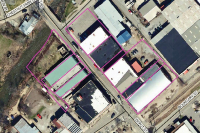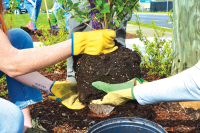Come winter, trees reveal their blemishes
Like an old man’s face, mature hardwood tree trunks are covered with blemishes that signal age: cankers, seams, burls, butt scars, sterile conks, and protrusions in the form of bracket fungi. Winter is the time to take a closer look at this somber side of the natural world.
Cankers are diseases in which lesions caused by a wide range of fungi and bacteria appear on the trunk and branches. When the infected tissue dies, the lesions then crack and split open, exposing underlying tissue to further infection.
Some cankers grow on a perennial basis, forming concentric rings in trunk bark with each cycle of growth. Because these patterns resemble targets the canker is sometimes referred to as target canket.
Other cankers — like the one now killing off the butternut tree here in Western North Carolina—- eat through the truck bark exposing darkened elliptical patches of the outer cambium.
Seams are long vertical or spiral cracks on tree trunks. They vary in size from a few feet to the entire length of the trunk. These are usually caused by wind, lightening, or frost and occur in all species; however, they are observed most frequently in beech because of the smooth, thin bark. Sometimes a seam will infold, forming a smooth turning pattern like a carefully tucked blanket.
Burls or galls are round to semi-round or elongate swellings of the trunk. They range in size from a few inches to several feet in length. Some are of unknown origin, but most are caused by insects, fungi, or an injury. Fantastically shaped burls on birch trees in the higher elevations of the mountains lend an eerie touch to that often fog-shrouded landscape.
Related Items
Butt scars are triangular-shaped openings at the base of trees commonly caused by fire and logging injuries. Sycamores are often inflicted with butt scars, resulting in large openings that livestock and even humans have been reputed to take refuge in during hard times. There are stories, perhaps true, that pioneer families sometimes lived in the openings formed by butt scars in huge virgin forest sycamores while building their cabins. The largest butt scar opening I have seen is one at the base of a tree on Bryson City Island Park, which is situated in the middle of the Tuckaseigee River within the Bryson City town limits. Two people can sit inside with relative ease.
Sterile conks are specialized, non-fertile fungous growths. They are rough, black to brown, often brittle masses of fungous tissue occuring around dead branch stubs, wounds, or cankers of living trees. The sterile conks that appear on beech trees look like small black patches of lava that have oozed out of the trunk and congealed in midair. The most interesting, for me, of the special growth forms under discussion here are the various bracket fungi that grown on tree trunks year around but become especially apparent during the winter months.
Some are shaped like a horse’s hoof, others like a turkey’s tail. Some are as large as dinner platters, others as small as your finger nail. Also known as pore fungi, bracket fungi belong to a family (Polyporaceae) whose members grow attached to decomposing logs and tree trunks.
Usually brackets are quite woody and hardened as compared with soft-bodied mushrooms. Because of this woody nature they tend to last much longer than other mushrooms, providing the opportunity to observe them from year to year.
My favorites among the bracket fungi are the birch brackets (Polyporus betulinus) and the artist’s conk (Ganoderma applanatum). As their name indicates, birch brackets grow only on birch, forming smooth-surfaced, downward-hanging fruiting bodies that one writer describes as “looking like a thick puffed-up pancake on top.” Visit the Joyce Kilmer Wilderness Area in winter and you’ll have little trouble spotting bouquets of birch brackets.
The bracket known as artist’s conk can grow to be more than two feet in diameter. They are found solitary or in groups and grow on hardwood stumps and logs as well as from wounds in living trees. They are not species-specific as are birch brackets and may appear on almost every hardwood or conifer species found here in WNC.
These cracked, furrowed, knobby growths are really so hard. That you have to utilize some kind of tool to prize then off a tree trunk. Larger specimens have been made into stools. In Mushrooms Demystified (1986), author David Arora calculates that a large artist’s conk (he found one monster weighing in at 26 pounds) “liberates 30-billion spores a day, 6 months a year – or over 5,000,000,000,000 (5-trillion!) spores annually.”
Since the white pore surface on the underside of the bracket bruises easily and stains permanently brown when scratched, they have been used to leave messages in the woods or as a means for making sketches, hence the common name artist’s conk.
Messages scrawled on artist’s conk brackets are sometimes left along the Appalachian Trail to advise stragglers of their hiking partner’s whereabouts or well-being.
(George Ellison is a naturalist and writer. He can be reached at This email address is being protected from spambots. You need JavaScript enabled to view it..)









